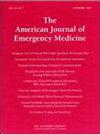The contribution of end-tidal carbon dioxide monitoring to the management of pediatric patients with diabetic ketoacidosis
IF 2.2
3区 医学
Q1 EMERGENCY MEDICINE
引用次数: 0
Abstract
Objective
In this study, the aim is to compare end-tidal carbon dioxide (EtCO2) values monitored in real-time via capnography, with venous blood gas partial pressure of carbon dioxide (PaCO2) values in children diagnosed with diabetic ketoacidosis (DKA) during diagnosis and treatment.
Methods
A total of 55 patients diagnosed with DKA, aged 0–18 years (mean age: 10.5 ± 4.1 years), were included in this prospective observational study. Of these, 27 had mild-to-moderate DKA and 28 had severe DKA. Patients were grouped as mild-to-moderate or severe based on blood gas values. Vital signs, blood gases and EtCO2 were monitored concomitantly. In this study, the agreement between PaCO2 (blood gas) and EtCO2 (capnography) values was examined, and the diagnostic test performance of EtCO2 and PaCO2 values was evaluated between DKA groups (mild-to-moderate/severe). SPSS (Statistical Package for the Social Sciences) version 25.0 software was used for statistical analysis.
Results
A positive linear correlation was found between EtCO2 and PaCO2 values at admission and throughout monitoring. For detecting patients with GCS ≤ 13, the cut-off values were EtCO2 < 12 mmHg and PaCO2 < 12.1 mmHg. The sensitivity, specificity, and AUC for EtCO2 were 78.57 %, 92.59 %, and 0.907, respectively; and for PaCO2, 25 %, 100 %, and 0.665, respectively.
Conclusion
Our results show that patients with DKA can be monitored instantly with EtCO2, thereby reducing the need for invasive procedures in children.
Clinical Trials Number: NCT06327737.
潮末二氧化碳监测对小儿糖尿病酮症酸中毒管理的贡献。
目的:本研究旨在比较糖尿病酮症酸中毒(DKA)患儿在诊断和治疗过程中实时监测的潮末二氧化碳(EtCO2)值与静脉血气体二氧化碳分压(PaCO2)值。方法:本前瞻性观察研究共纳入55例诊断为DKA的患者,年龄0-18岁(平均年龄:10.5±4.1岁)。其中,27人患有轻度至中度DKA, 28人患有重度DKA。根据血气值将患者分为轻度至中度或重度。同时监测生命体征、血气和EtCO2。本研究检测PaCO2(血气)与EtCO2(血糖)值的一致性,并评价各组(轻度至中度/重度)之间EtCO2和PaCO2值的诊断试验性能。采用SPSS (Statistical Package for Social Sciences) 25.0版软件进行统计分析。结果:入院时和整个监测过程中,EtCO2与PaCO2值呈线性正相关。结论:我们的研究结果表明,使用EtCO2可以即时监测DKA患者,从而减少了儿童有创手术的需要。临床试验编号:NCT06327737。
本文章由计算机程序翻译,如有差异,请以英文原文为准。
求助全文
约1分钟内获得全文
求助全文
来源期刊
CiteScore
6.00
自引率
5.60%
发文量
730
审稿时长
42 days
期刊介绍:
A distinctive blend of practicality and scholarliness makes the American Journal of Emergency Medicine a key source for information on emergency medical care. Covering all activities concerned with emergency medicine, it is the journal to turn to for information to help increase the ability to understand, recognize and treat emergency conditions. Issues contain clinical articles, case reports, review articles, editorials, international notes, book reviews and more.

 求助内容:
求助内容: 应助结果提醒方式:
应助结果提醒方式:


